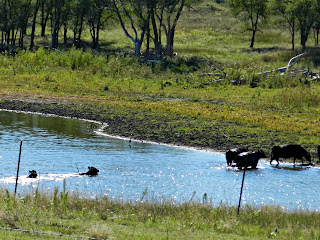While calendars tell us summer is over and fall has begun,
hordes of giant dragonflies ride still-warm breezes and wasps hover over ripe
fruits. Summer birdsong tricks us into believing there’s plenty of time for a
second round of ripe tomatoes and okra or many late season dips in a lake or
pond. The reality is that frosty mornings are not far off. It won’t be long
before summer tunes are silent, insects and birds will vanish, green leaves
will turn to dry husks, and ice will crust ponds and lakes.
Driving to school in the shadow of a setting harvest moon on
the final day of summer reminded me that morning sunrises would soon silhouette
bare branches instead of peep through foliage. Currently, on my morning route, gold
tones tint cottonwood leaves. Flocks of vultures congregate on elevators and tall
antennae but no longer stretch wings to welcome sunrise. It’s too chilly. Mist or
low lying clouds rise and float just above stubble fields and farm ponds,
telling me ground and water temperatures differ from those of morning air.
Despite signs that we are on the cusp of seasonal change,
most of us enjoy the moment and postpone thoughts of icy roads and water tanks,
snow covered driveways and sidewalks, and winter heat bills. We turn our faces
to capture last warm rays and savor final cicada serenades. Some creatures
literally immerse themselves in these last moments.
While cool temperatures created a smoke-on-the-water effect
over a big pond on my morning path, by the time of my late afternoon return,
those mists were long gone. The sun’s reflections glittered on the steel blue
water as a heron stood sentinel on a dead tree branch. It was so pretty I
stopped to take pictures.
Backlit by fall’s bright yellow sun, a herd of black cows
crowded the water’s edge, mucking about in mud. Suddenly, one stepped into the
pond and continued heading west. In the way that only cows know, the rest chose
to follow their leader.
At first, the train of bovines waded in knee (do cows have
knees?) deep. Slowly, water covered those ungainly bodies to the point I saw
only ears and noses moving forward. Several times, even those dipped below the
surface until I wondered who saved drowning cattle. Although I had been a
lifeguard decades ago, I knew these huge beasts were beyond my rescue abilities.
Despite my concern, V’s of ripples continued moving across
the pond until two black ovals and a big black squared reappeared from each. A
bit at a time, the rest of those cumbersome forms emerged, shaking water droplets
from their hides. Each spray reflected sunlight until it looked as if diamonds splintered
off the black shapes.
I only watched the first members of the herd complete their
swim across the deep pond before I drove off, smiling. It won’t be long before
that water is too cold or too frozen for even thick hided Angus to cross.
Watching cow dipping was a great way to enjoy my last day of summer 2013.








